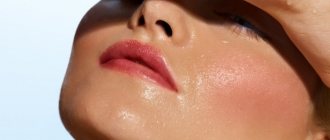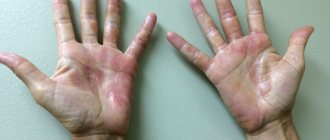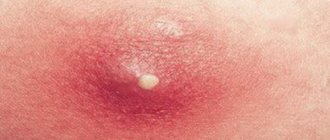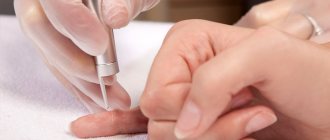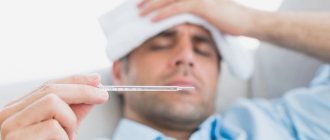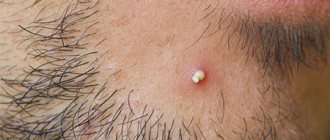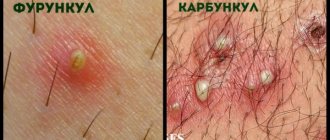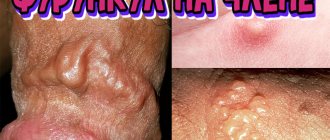What is a boil and why is it dangerous?
Boil is a purulent-necrotic inflammation of the hair follicle. It can be located in the area of the outer ear, concha and auditory canal.
Boils in the ears are not particularly dangerous if the pus does not get inside the ear canal. However, their formation indicates a general weakening of the body, impaired immune status, and hormonal imbalance. Without treatment, otitis media and furunculosis of the external ear will not have to wait long. And they cause various complications, for example, inflammation of the brain (meningoencephalitis). Therefore, if a lump forms and itching inside the ear, you should urgently go to the hospital and see an otolaryngologist. You can notice a boil by its characteristic symptoms, which vary depending on the location of the abscess.
In the auricle
You can notice a boil visually if it is located on open areas of the shell, or by painful sensations and compaction that can be felt with your fingers.
The pain intensifies when you press your finger on the tragus or lower wall of the auricle, as well as when you pull back the earlobe (if the abscess is located on the earlobe).
This happens because the affected tissues swell. Additional symptoms indicating that it is the furuncle of the auricle that has arisen may be as follows:
- inflammation of regional lymph nodes (located next to the auricle);
- migraine-like pain;
- temperature 37-38°C;
- general malaise in the form of weakness, nausea, drowsiness.
In the external auditory canal
The boil of the external auditory canal is difficult to see, but can be noticed by the above symptoms, as well as by additional signs:
- pain goes to the jaw or neck;
- there is a feeling of stuffiness in the ears (this is a specific symptom);
- noise is heard, ringing in the ears;
- Possible pain when swallowing.
A furuncle of the external ear is extremely dangerous. This is due to its location inside the head and proximity to important nerves leading to the brain. Therefore, the likelihood of possible complications in this case increases significantly.
Behind the ears
A boil behind the ear is a common occurrence, especially when compared with the previous options. It is noticed already at the stage of purulent inflammation, since it is impossible to see such a boil in the mirror. The main symptoms are standard:
- pain;
- swelling behind the ear outside;
- increased pain when pressing on the boil;
- temperature;
- migraine.
Most often, it is with such a lesion that the regional lymph nodes become inflamed: behind the ear, submandibular, cervical. An abscess must be handled with extreme caution; due to its proximity to the lymph nodes, it can quickly spread infection throughout the body and provoke sepsis.
How to treat a boil behind the ear
As medical practice shows, a boil on the ear is a fairly common problem with which both children and adults turn to an ENT doctor.
The disease is associated with the penetration of pathogenic microbes, most often represented by staphylococci, into the hair follicles, where the process of inflammation begins. The fact is that such a problem not only causes cosmetic inconvenience, but also causes pain to a person, sometimes so strong that going to a medical facility is simply necessary.
What is a boil or boil in the ear?
A furuncle or boil is an acute purulent inflammation of the sebaceous glands, hair and surrounding tissue structures. You can find a boil in the ear, behind it, on the lobe or inside the auricle, which is much more dangerous. The worst thing is if the boil appears in the ear canal.
Externally, the inflammation is similar to a regular pimple, because it is represented by an abscess with an accumulation of pus and a necrotic core inside, but it differs in its growth to large sizes and accompanying symptoms.
The next stage is characterized by suppuration, which ends with necrosis of the inflamed tissues, and takes about 4 days, after which, as a rule, the abscess opens on its own. After this, a period of skin regeneration and healing of the resulting wound begins.
Why does it appear?
As already noted, the main pathogens of pathology are Staphylococcus aureus, which is found both in the external environment and in the human body.
The presence of Staphylococcus aureus is not always accompanied by the development of furunculosis.
What else causes boils? After all, activation of the pathogen occurs only under favorable conditions, which are:
- tissue damage through which infection can enter the body;
- decreased immunity, as a result of which harmful microorganisms do not meet the proper protective reaction from the immune system after entering the body;
- state of vitamin deficiency;
- treatment of other serious pathologies, accompanied by the use of strong medications in large quantities;
- failure to comply with personal hygiene rules to keep the area around the ear and auricle properly clean;
- severe hypothermia;
- some diagnosed ailments, such as diabetes mellitus, hormonal imbalance, dysfunction of the endocrine system;
- genetic predisposition;
- penetration of water into the ear and its stagnation, because conditions of high humidity are considered quite favorable for the reproduction and spread of Staphylococcus aureus.
Symptoms of occurrence
As a boil develops on the ear or inside the auricle, the patient experiences various symptoms, namely:
- itching, discomfort and redness of the skin, which is characteristic of the first stage of boil development;
- swelling of tissues;
- soreness, which is characteristic of the stage of formation of pus inside the abscess;
- enlarged lymph nodes located near the ear;
- an increase in temperature and a deterioration in general condition, which may indicate the spread of infection.
Separately, you should consider such a symptom as pain. When the boil is localized on the outside of the ear, pain, as a rule, is observed only upon palpation and can be quite strong. In this case, the elevation of the boil above the surface of the skin is difficult to miss.
The situation is completely different with boils that develop in the inner part of the ear, which may not be externally visible to the patient.
In this case, a person may experience a feeling of ear fullness due to tissue swelling.
As for pain, it most often manifests itself when turning the head or moving the jaw. The pain can be shooting in nature and radiate to other areas of the head.
How can it be dangerous?
A single boil on the ear is not a serious problem, but a more dangerous situation is the formation of an abscess inside the ear. The main complications of the pathology are presented:
To avoid the development of these complications, it is recommended to closely monitor your health status and promptly seek qualified help when identifying a developing boil.
This is what a boil or furuncle looks like in the photo.
What to do?
What to do if you discover this disease? As already noted, squeezing out the boil is strongly not recommended, because medications, traditional methods of treatment, as well as surgery are more effective and safe.
Source: //zodiacc.ru/info/furunkul-za-uhom-kak-lechit/
Reasons for appearance
Furunculosis is provoked by bacteria staphylococci and streptococci, which are present on the skin of every person.
Bacteria cannot cause harm until the immune system is weakened.
Immunity is reduced:
- chronic diseases of the ear, nose and throat (tonsillitis, otitis media, sinusitis);
- hormonal imbalances;
- diabetes;
- endocrine diseases;
- hypothermia;
- stress;
- hidden infections;
- Unhealthy Lifestyle.
The aggressiveness of bacteria can be increased by microtraumas in the ear that a person creates due to improper care: during too intensive cleaning of the ears and picking at them. In wounds, bacteria receive comfortable conditions for reproduction (dark, humid, warm).
Another common cause of boils in the ear is water ingress. Stagnant water also serves as a comfortable condition for the proliferation of pathogenic microorganisms that live on the skin.
Stages of abscess maturation
A boil in the ear goes through several stages during the maturation process:
- The formation of the infiltrate takes several days. It is at this moment that it is ideal to begin treatment, since the disease can be stopped in the bud. Stage symptoms: itching, redness, increased body temperature, mild swelling. A small compaction appears, and a purple or bluish swelling forms at the site of the infection. Discomfort and pain are added when pressing on the affected area.
- The purulent-necrotic stage begins with the formation of a rod inside the boil. Pus collects under the rod, and necrosis begins in the soft tissues. The boil grows until it bursts due to overflowing with pus. All unpleasant sensations intensify.
- 3-4 days after the start of the purulent process, the boil breaks out and the recovery stage begins. It’s good if the purulent contents flow out of the ear, but it happens that it flows deeper, and this is dangerous. Symptoms gradually subside if furunculosis does not become chronic. In the second case, repeated suppuration forms in the area of the diseased ear, sometimes even multiple (carbuncle).
The formation of a boil in the ear is not immediate. The first stage lasts 2-4 days, the second 3-5 days. The duration of the recovery period varies from 1 to 2 weeks.
Abscess behind the ear treatment at home
One of the most unpleasant and painful diseases of the ENT organs is a boil in the ear. Both adults and children are susceptible to this acute purulent-necrotic inflammation.
A boil can form in the external auditory canal. This is its most dangerous localization, since there is a risk of further spread of inflammation - to the area of the middle ear and eardrum.
It happens that a boil appears behind the ear or on the front side of the auricle. The inflammatory process affects the cartilage tissue, causing noticeable pain. Ulcers sometimes appear on the lobe - they are the most accessible for treatment.
According to the International Classification of Diseases, skin abscess, boil and carbuncle of the face are assigned the code L02.0. L02.8 - this code according to ICD-10 has a skin abscess, boil and carbuncle of other localizations, including an abscess in the ear.
We recommend reading our next article about the causes and methods of treating a boil on the face at this link.
Reasons for the appearance of chiryak on the auricle
An abscess in the auricle affects the hair follicle, sebaceous glands and neighboring tissues. It can be single, but if there are multiple boils, we are talking about furunculosis.
Such widespread spread of purulent inflammation is subject to mandatory treatment by a specialist.
Bacteria constantly live on the skin, but under certain conditions they become causative agents of the infectious process:
- in case of accidental mechanical damage - bruises, burns, microcracks, wounds resulting from careless shaving, earlobe piercing;
- with improper ear hygiene, the skin is often damaged when cleaning with cotton swabs or toothpicks. This can cause infection in the ear canal;
- with increased sweating, blockage of the sebaceous glands, discharge of purulent exudate from the middle ear.
There are a number of other factors that contribute to the development of boils in the ear area:
- decreased immunity as a result of chronic and infectious diseases;
- diabetes mellitus and other metabolic disorders in the body;
- autoimmune diseases;
- genetically determined predisposition;
- severe hypothermia;
- vitamin deficiency.
Symptoms of an abscess in the external auditory canal
At the first symptoms of the disease, treatment should begin immediately. At the initial stage (infiltration), the development of the boil can be stopped.
What signs indicate the occurrence of an inflammatory process:
- swelling, redness, burning, tingling and itching are observed in the affected area;
- when pressed, the patient feels pain and discomfort;
- discomfort during any movements of the jaw - talking, chewing, swallowing;
- headache;
- throbbing painful sensations can radiate to the temples, back of the head, neck, and eye area;
- parotid lymph nodes enlarge;
- the temperature rises, signs of intoxication of the body are observed;
- Hearing may be impaired, noise, ringing and buzzing may be felt in the ears;
- The patient has nervousness and irritability.
The localization of the abscess in the ear canal has its own characteristics. Its emergence and development occurs in a confined space.
The resulting infiltrate puts pressure on pain receptors, causing severe, sometimes unbearable pain. Intense pain increases at night, depriving a person of sleep.
Chiryak formation occurs in stages:
- At the stage of infiltration, hyperemia and itching are observed in the affected area; upon palpation, swelling and compaction of the tissue are felt. The cone grows quickly and is shaped like a cone up to 2 cm in diameter. Any touch hurts. The patient's temperature rises, appetite and sleep disappear.
- At the next stage of the disease, suppuration and necrotization of soft tissue occurs. At the top of the cone-shaped lump, a purulent head with a black core is noticeable. The formation of pus lasts on average 3–4 days.
- Then the fully mature boil is opened, the purulent contents flow out and the wound begins to heal. When the boil bursts, the pain subsides and the patient feels a noticeable improvement in well-being.
On average, the entire process of ripening and opening lasts a week, with about 10 more days required for healing.
Photo of a boil in the ear
Our article will tell you how chickenpox is transmitted.
Symptoms, photos, treatment of pyoderma are discussed in detail in this publication.
You can find a photo of herpes on the face (cheek, forehead, chin) here: //udermatologa.com/zabol/gerp/lechenie-gerpesa-na-litse-foto-podborodke-shheke-lbu/
What to do if you have a chiry in your ear
At the first symptoms of a boil in the ear, you should immediately go to the hospital to see an otolaryngologist. He will order an ear smear (bacterial culture) to find the pathogen, as well as blood tests to determine sepsis, diabetes, and hormonal imbalance. After diagnosis, the doctor will individually select treatment for the boil in the ear, taking into account the cause of its formation.
How to cure a boil in the ear with pharmaceutical drugs
The basis of treatment is the fight against pathogenic bacteria: staphylococci and streptococci.
General antibiotics are prescribed to kill bacteria:
- Amoxicillin (penicillin);
- Tetracycline;
- Levomycetin for external use;
- Cefazolin or Cefotaxime;
- Rifampin, Rifabutin (for chronic or multiple furunculosis).
Antibiotics in tablet form are taken orally for 5-7 days. This is a standard course of therapy using the above medications, which the doctor can adjust if indicated. Antibacterial treatment is prescribed for high fever, sepsis, and inflammation of the lymph nodes.
Additionally, you need to undergo a course of physical procedures: UHF and laser irradiation. General strengthening therapy is also carried out:
- vitamin tablets;
- immune stimulants;
- immunization with staphylococcal toxoid (so that the body develops antibodies to staphylococcus).
Surgical opening of a purulent focus
If an abscess in the ear is discovered before it is opened, then it is better to remove the pus in a hospital setting in order to control this process. Before surgically opening the ear, the doctor administers local anesthesia, then treats the ear with antiseptics and opens the abscess with a scalpel. After removing the pus and the rod, the cavity is lubricated with a 5% iodine solution. Subsequently, the patient is prescribed antiseptics for local wound treatment (miramistin, furatsilin, chlorhexidine).
How to treat at home
Treating a boil yourself is extremely risky.
But if it is not possible to visit the hospital, then you should use drugs with antiseptic and anti-inflammatory effects that accelerate the process of maturation of the abscess:
- Ichthyol ointment;
- Vishnevsky ointment;
- boric alcohol or acid.
Classic method of therapy: cotton swabs soaked in boric alcohol are inserted into the ear canal. This drug destroys microbial proteins, causing bacteria to quickly die. Boric acid inhibits the growth of microorganisms and also accelerates the maturation of the abscess.
Additionally, you can try traditional methods of treatment:
- lubricate the abscess with aloe juice;
- add fried onion without fat;
- smear with garlic or onion juice;
- make a compress from plantain leaves.
During treatment, it is recommended to sleep on the side of the boil to prevent pus from leaking inside if it bursts during the night. When coming into contact with an abscess, you need to treat your hands with an antiseptic, and then wash them thoroughly with soap so as not to spread the infection. At high temperatures (over 39°C), you can take Paracetamol or Nurofen. To prevent sepsis, you should follow a fortified diet without junk food and alcohol and drink plenty of fluids (drink at least 1.5 liters of clean water per day).
What to do if the boil has matured and burst on its own
If the abscess has ruptured and pus has flowed out of the ear, you need to treat the ear canal with an antiseptic (miramistin, chlorhexidine), and then drip an emulsion - streptomycin or 1% chloramphenicol. If the pus does not drain out, then you need to urgently go to the hospital.
How to treat ear furunculosis
How to treat ear furunculosis
Boils in the ear are a fairly common annoying problem. Many people believe that boils in the ear occur due to a cold. But in fact, there are many more reasons for this disease.
The cause may be weakened immunity, hypovitaminosis and other various chronic diseases. It also often occurs due to hormonal surges. In adolescents, it can even occur due to non-compliance with personal hygiene rules.
The most common reason for the appearance
Yes, boils occur for many reasons, but the most basic is mechanical impact.
It occurs due to microtraumas that we inflict on ourselves when we scratch or pick at our ears with inappropriate objects - matches, toothpicks, safety pins, pencils or hairpins.
Everyone knows that staphylococcus is present almost everywhere in our body. By inflicting microcracks on ourselves, we open the way for it to enter the skin, and then, due to the activity of staphylococcus, the cracks suppurate.
In fact, inflammation can also occur due to a cold if water gets into the ear. Those who like to walk without a hat in frosty, humid and windy weather are especially susceptible to ear furunculosis.
Boils are boils that occur in hair follicles. They can occur anywhere because hair follicles are found on almost the entire area of our skin.
How to recognize inflammation
An ear boil is one of the most painful and unpleasant problems. The first signs of inflammation are redness of the skin, or hyperemia, mild itching and swelling. Over time, if left untreated, the pain gets worse.
Also, due to the occurrence of an ear boil, piercing ear pains of a shooting nature, bursting headaches, radiating to other organs, such as the eyes and jaw, may appear.
Judging by all these factors, this disease significantly reduces a person’s ability to work, makes him hot-tempered and irritable, which greatly complicates the life of children and those who are engaged in mental work.
When the ear becomes inflamed, it even hurts to touch it. This pain gets worse if you chew, talk, or simply move your head. Severe pain prevents you from sleeping peacefully, it causes your teeth to ache, your lymph nodes become inflamed, and your temperature rises.
When the ear is very swollen, it protrudes. As in any other cases, the help of a qualified doctor is necessary. Self-medication can lead to complications and relapse.
During treatment, you should carefully monitor your cleanliness so that the infection does not spread to nearby healthy tissue.
Washing with a stream of warm water is strictly prohibited.
It is contraindicated to wash your hair and go to the bathhouse.
In those people who constantly experience purulent inflammation, most likely, staphylococcus is already in the blood. In this case, an examination is indicated, since until you clear your blood of staphylococcus, abscesses will still appear again and again.
During treatment, drugs with immunomodulatory and antibacterial effects, antipyretics, anti-inflammatory and analgesics are prescribed. Warming up the ear is also often prescribed, due to which the boil will ripen faster and the pain will be relieved.
Antibacterial drugs prescribed for this disease
In standard cases, drugs such as erythromycin, tetracycline and Rulide are most often prescribed; in special advanced cases, injections with antibiotics should be used. Local treatment is required.
For this, boric alcohol is suitable, in which the earpieces are moistened, and then carefully inserted into the ear.
In rare cases, autohemotherapy is used: two or three injections of a person’s own blood are given intramuscularly every 48 hours.
As soon as the boil appears, use compresses soaked in vodka
Next, you can resort to ultraviolet irradiation, exposure to a blue lamp and UHF. If the boil has already opened, then to remove the remaining pus, turundas are used, lubricated with special ointments that draw out the pus.
In the last stage of ear furunculosis
When the boil is almost ripe, there is often severe itching. To reduce it, use boric vaseline. Very often, the boil can open on its own. In this case, the pain is significantly reduced and the boil is treated within a week.
Boils are dangerous
The disease of ear furunculosis is fraught with thrombophlebitis and sepsis. Boils on the scalp are the most dangerous. They are located near the brain, so infection can easily be transmitted through the blood and the meninges can become inflamed. Treatment of boils should not be neglected.
If the boil is not treated correctly, the inflammation can also spread to nearby hair follicles, that is, a carbuncle may occur.
Carbuncles are much larger than boils; they affect not only the hair follicles, but also the subcutaneous tissues.
It is much more difficult and serious to cure a carbuncle than a boil, and sometimes it can lead to fatal consequences. In almost all cases, they leave behind unsightly scars.
Source: //zen.yandex.ru/media/vsoobovsom/kak-lechit-ushnoi-furunkulez—5ab8bd8b20ea2b158f037c5a
What to do if there is a boil in a child’s ear
A child with a boil in the ear should be taken to a pediatrician, and he will refer him to other specialists. Children try not to be prescribed antibiotics in the form of tablets, as they negatively affect the gastrointestinal tract and have serious side effects.
For the treatment of children, ointments with an antimicrobial effect are more suitable, for example, Levomekol, Tetracycline, Dimexide.
If the boil in a child’s ear is located deep, then it is better to use antibacterial drops Ofloxacin or Neomycin.
Relapse Prevention
To prevent relapses of furunculosis in the future, it is recommended:
- wash your hands thoroughly before touching your ears and follow other rules of personal hygiene;
- unlearn the habit of picking your ears;
- clean only the outer parts of the sink and do not stick a stick into the channel;
- take vitamins and strengthen your immune system;
- lead an active, healthy lifestyle;
- treat chronic infections of the ENT organs and others in a timely manner;
- maintain hormonal levels and fight endocrine disorders;
- avoid stress.
Furunculosis occurs as a result of the influence of various factors, ranging from non-compliance with basic hygiene to severe disruptions in the functioning of the body. A healthy lifestyle and regular medical examinations will help reduce the risk of this disease, and proper treatment as recommended by a doctor will prevent relapses.

